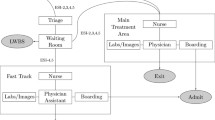Abstract
In Canada, acute care refers to the in-hospital treatment of a disease during its initial phases (typically measured in days). Determining how bed availability impacts patient access to care is of great interest to the British Columbia (BC) Ministry of Health Services and to the health service delivery industry worldwide. In this article we discuss a simulation queueing theory model with three input streams consisting of Emergency, Direct Elective and Direct Transfers, designed to examine the question of how bed counts impact access to acute care services inBC's hospitals. We further develop an optimization algorithm to determine optimal bed allocations among hospital segments in order to minimize average patient wait time. The algorithm is demonstrated on an exemplar hospital.




Similar content being viewed by others
References
Barer ML et al (1989). Trends in use of medical services by the elderly in British Columbia. Can Med Assoc J 141 (1): 39–45.
Bergheim S (2006). Live Long and Prosper! Health and Longevity as Growth Drivers. Deutsche Bank Research: Frankfurt, Germany, pp 1–15.
Bose SK (2001). An Introduction to Queueing Systems. Kluwer Academic/Plenum Publishers: Norwell, MA, USA.
Cochran JK and Bharti A (2006). Stochastic bed balancing of an obstetrics hospital. Health Care Manage Science 9: 31–45.
College of Physicians and Surgeons of Ontario (2004). Tackling the Doctor Shortage: A Discussion Paper, pp 1–22.
Collier R (2008). Diagnosing the aging physician. Can Med Assoc or its Licensors 178 (9): 1121–1123.
Cooper RA, Getzen TE, McKee HJ and Laud P (2002). Economic and demographic trends signal an impending physician shortage. Health Affairs 21 (1): 140–154.
Darzi EE, Vasilakis C, Chaussalet T and Millard PH (1998). A simulation modeling approach to evaluating length of stay, emptiness and bed blocking in a hospital geriatric department. Health Care Mngt Sci 1: 143–149.
Dhalla I (2007). Canada's health care system and the sustainability paradox. Can Med Assoc J 177 (1): 51–53.
Fone D et al (2003). Systematic review of the use and value of computer simulation modelling in population health and health care delivery. J Public Health Med 25: 325–335.
Gorunescu F, McClean SI and Millard PH (2002). Using a queueing model to help plan bed allocation in a department of geriatric medicine. Health Care Mngt Sci 5 (4): 307–312.
Koizumi N, Kuno E and Smith T (2005). Modeling patient flows using a queueing network with blocking. Health Care Mngt Sci 8: 49–60.
Law AM and Kelton WD (2000). Simulation Modeling and Analysis 3rd edn, McGraw-Hill: Columbus, OH, USA.
Lewis PAW and Shedler GS (1979). Simulation of nonhomogeneous poisson processes by thinning. Nav Res Log Quart 26 (3): 403–413.
Mackay M and Lee M (2005). Choice of models for the analysis and forecasting of hospital beds. Health Care Mngt Sci 8 (3): 221–230.
Acknowledgements
All authors research supported in part by the BC Ministry of Health and the IRMACS Centre. Hare's Research supported in part by NSERC discovery grant 355571-2008.
Author information
Authors and Affiliations
Corresponding author
Rights and permissions
About this article
Cite this article
Wang, Y., Hare, W., Vertesi, L. et al. Using simulation to model and optimize acute care access in relation to hospital bed count and bed distribution. J Simulation 5, 101–110 (2011). https://doi.org/10.1057/jos.2010.7
Received:
Accepted:
Published:
Issue Date:
DOI: https://doi.org/10.1057/jos.2010.7




